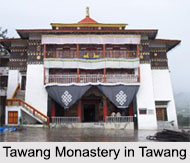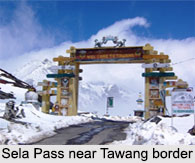 The area of Tawang is administered by the Republic of India as a part of the Arunachal Pradesh state; however, it is claimed by the People"s Republic of China as a part of South Tibet, under Tsona Dzong of Shannan, Tibet. The town once served as the district headquarters of West Kameng district, and became the district headquarters of Tawang district when it was formed from West Kameng.
The area of Tawang is administered by the Republic of India as a part of the Arunachal Pradesh state; however, it is claimed by the People"s Republic of China as a part of South Tibet, under Tsona Dzong of Shannan, Tibet. The town once served as the district headquarters of West Kameng district, and became the district headquarters of Tawang district when it was formed from West Kameng.
History of Tawang
Inhabited by the Monpa people, Tawang was historically part of Tibet. The name Tawang derives from two words from the local Monpa dialect Ta and Wang. Ta means horse and Wang means green pastures. The local interpretation is that in the 17th century, a Tibetan monk called Mera Lama found a strong and beautiful horse wandering in the valley. Attracted to this elegant animal, the Lama tried to capture it. But the horse disappeared and while searching for it, Mera Lama found a place, which was very serene and soothing. He built a magnificent Buddhist Monastery at the location. The town that developed around this Monastery was later called Tawang. Immersed in natural beauty the history of Tawang is seeped with mystery.
Geography of Tawang
The geography of Tawang has some variations in climatic conditions which occur within short distances, on account of the alterations in the local terrain. Portions of the Tawang district are existent on the mountain slopes of the Lesser Himalayan Mountain ranges which mainly experience warm and temperate climate. The average temperature in Tawang is about 10° C and receives an annual rainfall of almost 915 mm.
 Demographics of Tawang
Demographics of Tawang
As per the reports of Census India 2011, Tawang has a total population of 49,950. A sizeable population of 20,000 people lives in Tawang town. The dominant ethnic group are the Monpa, who inhabit all of the 163 villages. The Tibetans are also found in small scattered numbers throughout Tawang. The Takpa, a small tribal group, are found in small, scattered numbers in the West and the North.
Nearby Attractions of Tawang
In Tawang, there are mountains, deep valleys, monasteries, waterfalls and almost a hundred lakes. Listed below are some of the tourist attractions of Tawang:
Tawang Monastery: Founded by the Mera Lama Lodre Gyasto in accordance to the wishes of the 5th Dalai Lama, Nagwang Lobsang Gyatso. This monastery belongs to the Gelugpa sect and is the largest Buddhist monastery in India. The name Tawang means Horse Chosen. It is said to be the biggest Buddhist monastery in the world outside of Lhasa, Tibet. It is a major holy site for Tibetan Buddhists as it was the birthplace of the sixth Dalai Lama. It is also famous for snowfall which occurs every year during December-January.
The Sela Pass: It is a high altitude mountain pass located on the border between the districts of Tawang and West Kameng. The pass supports scarce amounts of vegetation and is usually snow-covered to some extent throughout the year. Sela Lake, near the summit of the pass, is one of approximately 101 lakes in the area that are sacred in Tibetan Buddhism. While Sela Pass does get heavy snowfall in winters, it is usually open throughout the year and attracts tourists unless landslides or snow require the pass to be shut down temporarily.
Other than these, there are magnificent lakes like the Pankang Teng Tso and the Tawanchu River, which are also quite famous in Tawang.
Visiting Information on Tawang
The nearest domestic airport is the Salonibari Airport at Tezpur, while the Lokpriya Gopinath Bordoloi International Airport is the closest international airport at Guwahati. The railway station of Tezpur is the closest and is connected to the all major cities of Arunachal Pradesh.



















